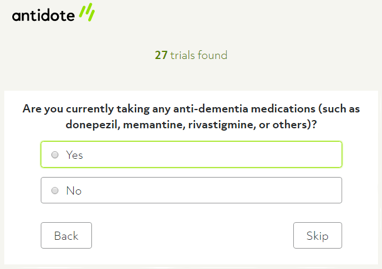Antidote Incorporates Patient Centricity in Subject Enrollment
The FDA’s launch of patient centric initiatives has led the industry to gear towards incorporating the patient’s voice in medical product development. Tom Krohn of Antidote discusses his company’s patient centered approach towards clinical trial matching by focusing on the patient.
A few years ago, the FDA announced the launch of patient centric initiatives, which led to the initiation of The Patient Preference Initiative and the Patient Engagement Advisory Committee, all geared towards incorporating the patient’s voice in medical product development. While subject enrollment has focused mainly on finding the right patients for specific studies, Antidote (formerly TrialReach) has taken a patient centered approach towards clinical trial matching by focusing on the patient. Tom Krohn, former Director of Clinical Open Innovation at Eli Lilly, and current Chief Development Officer at Antidote, will discuss the approach in this interview.
Moe Alsumidaie: Why has TrialReach rebranded to Antidote?
Tom Krohn

Tom Krohn: TrialReach was formed seven years ago and our business continues to evolve as we've grown and developed. Over the past year, we have realized that the current brand in TrialReach wasn't portraying the full scope of our work and the importance of our mission. TrialReach is what we do, but is not necessary who we are and who we aspire to be. We are a company that is focused on the patient. We are a healthcare IT company and we are looking to move beyond just a pharma frame of reference, and TrialReach is a pharma frame, not a patient frame. We are looking at expanding our capabilities beyond patient recruitment to concentrate on how we can serve patients, sites and sponsors. Antidote is a good and powerful change for us as we expand our vision and execute it.
MA: How has the TrialReach platform changed over the years? What investments and technological capabilities have been added to the platform?TK: We continue to invest in our platform, and our primary focus is to better engage and serve patients. The first emphasis is scale, and finding content that helps patients find studies. This starts with helping patients find a relevant study by focusing on structured eligibility questionnaires and machine learning algorithms. We initially had the diabetes therapeutic area covered (based on 900 Type 1 and Type 2 and diabetes studies). Now, with our more sophisticated matching capability, we have 5,300 studies across many conditions including neurocognitive diseases, such as Alzheimer's, neurodegenerative diseases like ALS, and autoimmune diseases like Lupus and psoriasis. By the end of the year, we will double that number by adding joint, kidney, GI, pain, atherosclerosis and mental disorders.

The second emphasis is to help patients understand the study. A key part for us is to not only help the patient find a relevant study but, to also help them understand it, and that's where Antidote Bridge comes in. It's really about recognizing that the public information of trials is often incomplete for patients and it is hard to understand. I have done readability analysis on the purpose statement of numerous studies and it is consistently above 22 years of education. Antidote Bridge is a free service to sponsors to help them add content in our platform to not only simplify studies, but, also improve their ranking to patients. I am pleased to say that we have a number of large biopharmaceutical enterprises who have committed to augment their studies with us. Antidote Bridge is open to all sponsors, and investigators; academic or industry.
When you bring patient engagement and understanding, matching patients to clinical trials comes to life in a much richer way. It is really about engaging and leading in the patient channel through this information.
MA: How does the platform dramatically reduce cost and time to find total participants?
TK: The traditional model of recruitment is to find the right site and advertise for patients. Finding the right site is based on historical performance and sometimes it works and sometimes it doesn't. Recruitment through advertisement can work, but it's expensive and because it’s typically broad, it also tends to be slow. Our model is focused on serving patients where they are; to help them find, understand and connect with clinical trials. The key is where they are and when they are looking. Our partnership growth has generated incredible patient reach and engagement opportunities, which allows us to target, and re-engage patients as they match to new study criteria. The combination of scale and quality results in cost savings and efficiency.
You can maximize enrollment and minimize screen failures by doing good matching, prescreening, and follow-up. I see lots of various types of digital companies that do advertisements that lead patients to sites which results in a lot of of false-positive screen failures. Antidote focuses on the study level, then leveraging our scalable platform to engage patients through the enrollment funnel. The quality from our perspective is pre-screening quality: prescreen patients as much as possible through algorithms.
MA: Is Antidote patient-centric?
TK: Yes. Most advocacy groups are supporting a disease area and a researcher around the disease area; they are not supporting a study, since it is neither their, nor the patient’s frame of reference. Antidote starts with the patient first and then sponsors engage us to perform value-added services, primarily around activating and engaging patient networks for a specific study, which includes prescreening and qualification. While a large portion of patients still are screening out through this process, they are still looking for options, and Antidote provides those options to patients. Antidote brings the best of both, the best of the study level, and the best of a therapeutic area to help give the patient options. That is key to being patient centric.
MA: The FDA is now starting to voice that they need sponsors to involve patients in the design of studies, and help sponsors determine valuable clinical outcomes measures. Are there any plans for Antidote to get involved in that space?TK: Yes, absolutely. As you scale and do sophisticated matching and engagement, you get significant patient and behavioral insights. We are generating insights such as intent to participate given certain study criteria, and what type of studies patients are matching to. These insights can help sponsors with not only designing their trials upfront, but, also amending their protocols during execution, as patient engagement data can flow back to design. A popular alternative is EHR feasibility analysis, however, this approach does not provide insights as to whether a patient is willing to participate in a study, or what factors veer a patient from not wanting to participating in a study.
We see us moving upstream into helping sponsors and researchers understand their design, the implications in the marketplace around that design, and evaluating what patients are looking for in clinical studies. We feel very strongly that our data will offer powerful insights, and provide value in the design and execution phases of a clinical trial.
Behind the Buzz: Why Clinical Research Leaders Flock to SCOPE Summit
February 7th 2025In this episode, we meet with Micah Lieberman, Executive Conference Director for SCOPE Summit (Summit for Clinical Ops Executives) at Cambridge Innovation Institute. We will dive deep into the critical role of collaboration within the clinical research ecosystem. How do we bring together diverse stakeholders—sponsors, CROs, clinical trial tech innovators, suppliers, patients, sites, advocacy organizations, investors, and non-profits—to share best practices in trial design, program planning, innovation, and clinical operations? We’ll explore why it’s vital for thought leaders to step beyond their own organizations and learn from others, exchanging ideas that drive advancements in clinical research. Additionally, we’ll discuss the pivotal role of scientific conferences like SCOPE Summit in fostering these essential connections and collaborations, helping shape the future of clinical trials. Join us as we uncover how collective wisdom and cross-industry partnerships are transforming the landscape of clinical research.
Reaching Diverse Patient Populations With Personalized Treatment Methods
January 20th 2025Daejin Abidoye, head of solid tumors, oncology development, AbbVie, discusses a number of topics around diversity in clinical research including industry’s greatest challenges in reaching diverse patient populations, personalized treatment methods, recruitment strategies, and more.